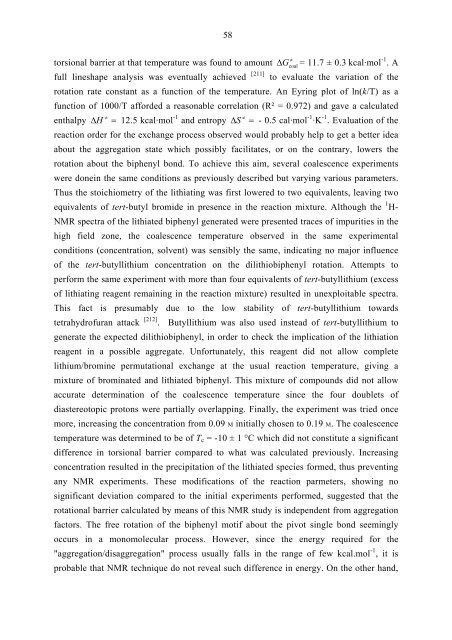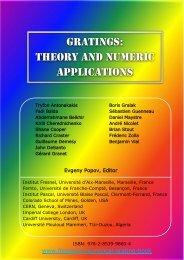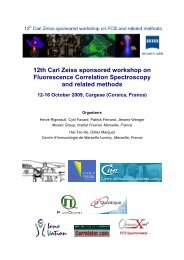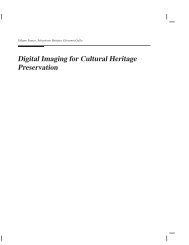My PhD dissertation - Institut Fresnel
My PhD dissertation - Institut Fresnel
My PhD dissertation - Institut Fresnel
Create successful ePaper yourself
Turn your PDF publications into a flip-book with our unique Google optimized e-Paper software.
58<br />
≠<br />
-1<br />
torsional barrier at that temperature was found to amount G = 11.7 ± 0.3 kcal·mol . A<br />
full lineshape analysis was eventually achieved<br />
∆ coal<br />
[ ] 211 to evaluate the variation of the<br />
rotation rate constant as a function of the temperature. An Eyring plot of ln(k/T) as a<br />
function of 1000/T afforded a reasonable correlation (R² = 0.972) and gave a calculated<br />
enthalpy ∆ =<br />
≠<br />
H 12.5 kcal·mol -1 and entropy ∆ = - 0.5 cal·mol<br />
≠<br />
-1 -1<br />
S<br />
·K . Evaluation of the<br />
reaction order for the exchange process observed would probably help to get a better idea<br />
about the aggregation state which possibly facilitates, or on the contrary, lowers the<br />
rotation about the biphenyl bond. To achieve this aim, several coalescence experiments<br />
were donein the same conditions as previously described but varying various parameters.<br />
Thus the stoichiometry of the lithiating was first lowered to two equivalents, leaving two<br />
equivalents of tert-butyl bromide in presence in the reaction mixture. Although the 1 H-<br />
NMR spectra of the lithiated biphenyl generated were presented traces of impurities in the<br />
high field zone, the coalescence temperature observed in the same experimental<br />
conditions (concentration, solvent) was sensibly the same, indicating no major influence<br />
of the tert-butyllithium concentration on the dilithiobiphenyl rotation. Attempts to<br />
perform the same experiment with more than four equivalents of tert-butyllithium (excess<br />
of lithiating reagent remaining in the reaction mixture) resulted in unexploitable spectra.<br />
This fact is presumably due to the low stability of tert-butyllithium towards<br />
tetrahydrofuran attack<br />
[ ] 212 . Butyllithium was also used instead of tert-butyllithium to<br />
generate the expected dilithiobiphenyl, in order to check the implication of the lithiation<br />
reagent in a possible aggregate. Unfortunately, this reagent did not allow complete<br />
lithium/bromine permutational exchange at the usual reaction temperature, giving a<br />
mixture of brominated and lithiated biphenyl. This mixture of compounds did not allow<br />
accurate determination of the coalescence temperature since the four doublets of<br />
diastereotopic protons were partially overlapping. Finally, the experiment was tried once<br />
more, increasing the concentration from 0.09 M initially chosen to 0.19 M. The coalescence<br />
temperature was determined to be of Tc = -10 ± 1 °C which did not constitute a significant<br />
difference in torsional barrier compared to what was calculated previously. Increasing<br />
concentration resulted in the precipitation of the lithiated species formed, thus preventing<br />
any NMR experiments. These modifications of the reaction parmeters, showing no<br />
significant deviation compared to the initial experiments performed, suggested that the<br />
rotational barrier calculated by means of this NMR study is independent from aggregation<br />
factors. The free rotation of the biphenyl motif about the pivot single bond seemingly<br />
occurs in a monomolecular process. However, since the energy required for the<br />
"aggregation/disaggregation" process usually falls in the range of few kcal.mol -1 , it is<br />
probable that NMR technique do not reveal such difference in energy. On the other hand,













